Cleaning dirty wood furniture can be easy and fun! Start by using a soft microfiber cloth to dust off any loose dirt—who knew dusting could be satisfying? For tougher grime, mix a little mild dish soap with water and gently wipe the surface—just avoid soaking it! If you see stains, don’t panic! A warm iron with a cloth can work wonders on water marks. Stick around, and you’ll discover more tips that’ll make your furniture shine!
Key Takeaways
- Begin by inspecting the wood furniture for any stubborn stains before cleaning to determine the best approach.
- Use a gentle solution of mild dish soap mixed with water on a damp microfiber cloth to clean surfaces without damaging the finish.
- For tough stains like grease, apply cornstarch or talcum powder to absorb the oil before wiping it away.
- Polishing with a plant-based product enhances the wood’s appearance while conditioning it and extending its lifespan.
- Always dry the furniture immediately with a soft towel to prevent watermarks and control moisture exposure.
Understanding Different Cleaning Methods
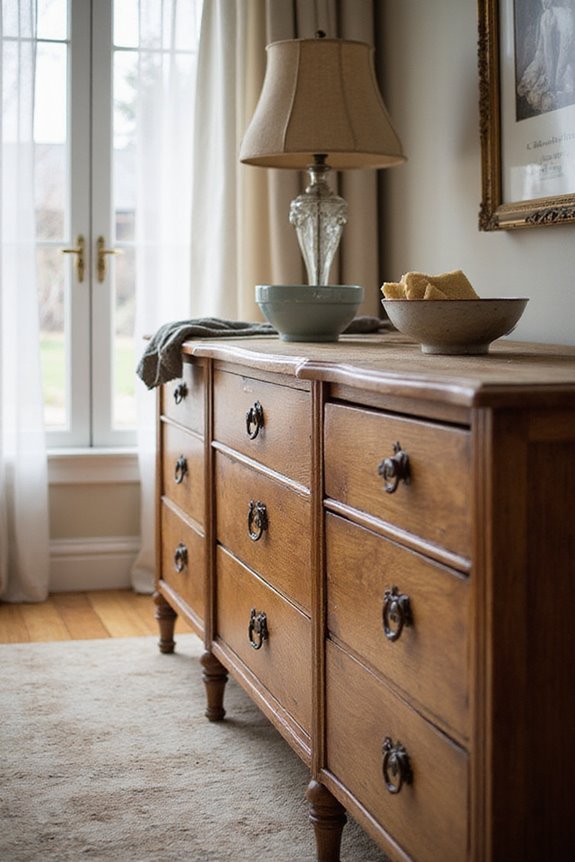
When it comes to cleaning wood furniture, you might wonder which method is the best for your beloved pieces. For a quick refresh, spray cleaners are super convenient! You can just spritz and wipe with a microfiber towel. Speaking of towels, they’re perfect for dusting, whether dry or a bit damp. Have you considered natural oils? They condition wood beautifully and leave a subtle sheen—great for showing off those grain patterns! Additionally, using appropriate cleaners for different materials is essential to avoid damage to your furniture.
Now, if you’re looking for a bit more shine, polishes and waxes can give you that glossy finish, but watch out for harsh chemicals! Oh, and remember, using gentle soap solutions is key for delicate woods. So, which wood care method will you try first?
Techniques for Deep Cleaning
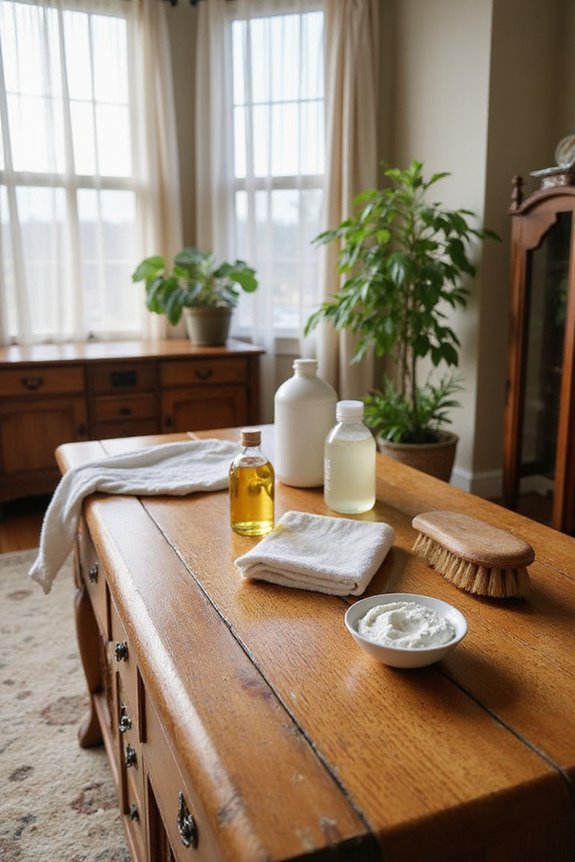
Ready to give your wood furniture a deep clean? Start by inspecting it for stubborn stains. It’s essential to control moisture, so use damp cloths—never soaking wet! Microfiber cloths work best as they’re gentle and effective. Mixing gentle dish soap with water creates a fantastic cleaning solution.
You’ll want to avoid any harsh chemicals since they can damage the wood’s finish. After deep cleaning, make sure to dry the surfaces with a soft towel to prevent those pesky watermarks! Additionally, using heat-resistant surfaces can help protect your furniture from future stains and damage.
Oh, and have you considered using boiled linseed oil or lemon oil afterward for that beautiful gleam? Your wood furniture deserves the best, right? Give these techniques a try, and watch your furniture shine!
How to Remove Specific Stains
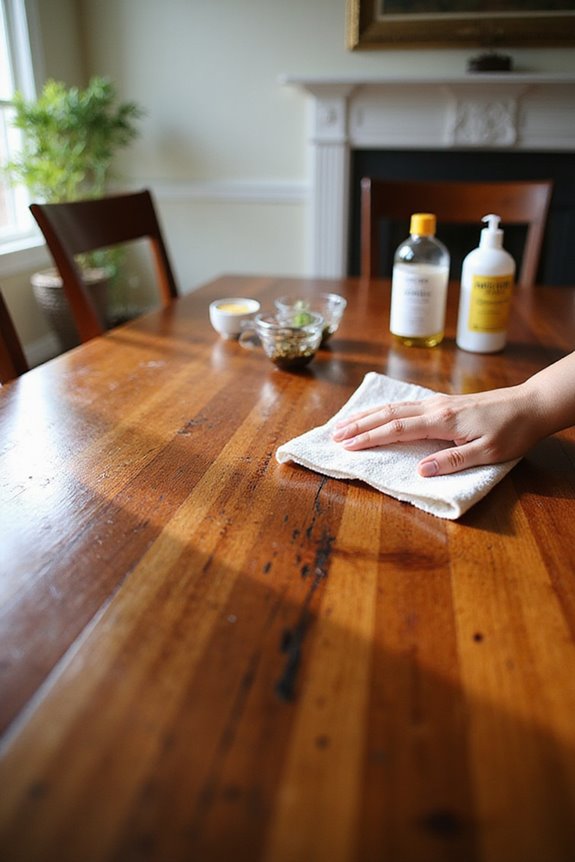
You might have your cleaning supplies in hand, feeling proud after a deep clean of your wood furniture. But what about those pesky stains? Water stains can be tackled with a warm iron and cloth—just remember, it’s a quick touch. For ink stains, try dabbing a vinegar and water solution or a drop of mineral spirits on a cloth.
Got grease stains? Sprinkling cornstarch or talcum powder helps absorb that excess oil! And heat marks? Just use that warm iron trick again (you’re becoming quite the expert!). With these simple methods, you’ll bring your wood furniture back to life and impress your friends! Additionally, maintaining durable materials in your furniture can help prevent future stains. What do you say, ready to plunge into some stain-busting action?
Tips for Polishing and Conditioning Wood
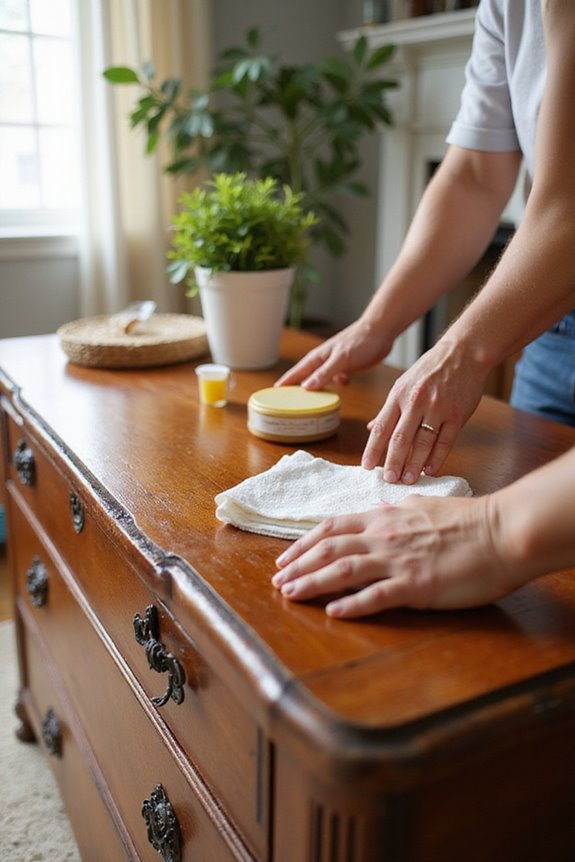
Polishing and conditioning your wood furniture can feel like giving it a spa day—it’s all about bringing out that natural shine! Have you considered the different polish types available? Plant-based options like almond polish can truly nourish your wood. Don’t skip cleaning first! A soft cloth with mild soap works wonders to prep the surface.
Next, apply polish using circular motions and buff it out until you see that beautiful gleam! What about conditioning benefits? Conditioning not only feeds the wood but also protects it, extending its lifespan. Regularly applying a thin layer creates a barrier against stains. Remember, a little care goes a long way; your cherished pieces will appreciate it! Additionally, choosing vintage leather sofas can complement your wood furniture beautifully, enhancing the overall aesthetic of your living space. Ready to give your furniture the pampering it deserves?
Essential Safety Precautions
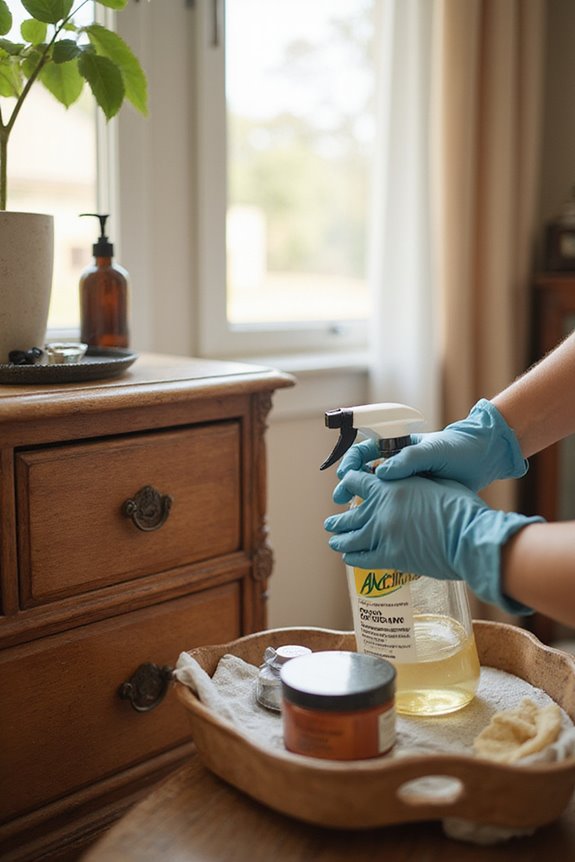
Now that you’ve pampered your wood furniture with some polish, it’s time to talk about keeping it safe and sound. First things first—use the right cleaning tools! Soft microfiber cloths are your best friends. Ever tried cleaning with paper towels? They can leave scratches! Keep your cleaning solutions gentle, too. Avoid harsh chemicals like ammonia or bleach; they can cause real headaches!
Instead, opt for water-based cleaners. Oh, and don’t forget to control moisture—too much can warp that beautiful wood! Dry spills immediately and never soak your furniture. Finally, watch out for heat and impact damage. Trivets are a must for hot items. Who wants dents on their lovely furniture? Keeping it safe is key to lasting beauty! Additionally, consider using durable materials for your furniture, as they can enhance longevity and maintain aesthetic appeal.
Effective Maintenance Tips
When it comes to maintaining your wood furniture, keeping it looking its best is easier than you might think! Start by dusting every 7-10 days using soft, dry cloths or microfiber. Ever tried a feather duster? They’re fantastic for light particles! Got pets or a busy household? You might want to dust even more frequently.
As for cleaning, a damp cloth with mild dish soap works wonders. Just remember to always dry off the surface right after. Protecting your pieces is essential, so don’t place hot items directly on them—use coasters instead! By mastering these dusting techniques, you’ll enhance furniture longevity and keep those gorgeous grains shining. Who knew maintenance could be this simple?
Frequently Asked Questions
Can I Use Vinegar on Wood Furniture?
Yes, you can use vinegar on wood furniture. Its benefits include effective wood cleaning and non-toxic properties. Just remember to dilute it properly, as undiluted vinegar can damage finishes and dull the wood’s appearance.
How Often Should I Clean My Wood Furniture?
Just like a garden flourishes with regular care, your wood furniture needs nurturing too. Embrace weekly maintenance for dust, and don’t forget seasonal care to keep its beauty intact and thriving for years to come.
What Is the Best Cloth for Cleaning Wood?
When considering the best cloth for cleaning wood, microfiber cloths are ideal for trapping dust, while soft cotton rags can safely wipe surfaces. Always guarantee they’re lint-free to protect your furniture’s finish.
Can I Use Bleach on Wood Surfaces?
You shouldn’t use bleach on wood surfaces due to potential damage. Instead, consider bleach alternatives like mild soap or specialized cleaners to guarantee wood protection and maintain its integrity and appearance without harsh chemicals.
Is It Safe to Use Water on Finished Wood?
Imagine your finished wood piece as a delicate dance partner; too much water can lead to disastrous missteps. To avoid water damage, you should minimize moisture exposure and choose cleaner methods suited for your wood finishes.





